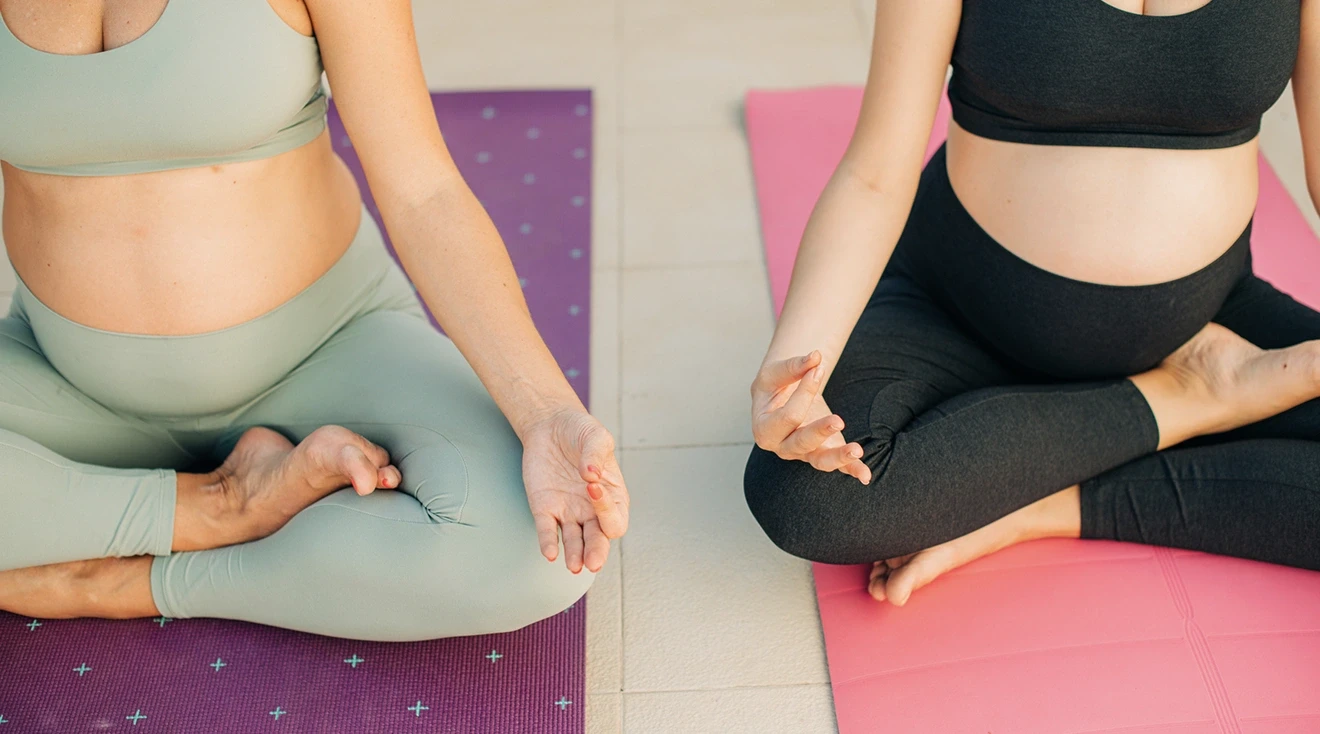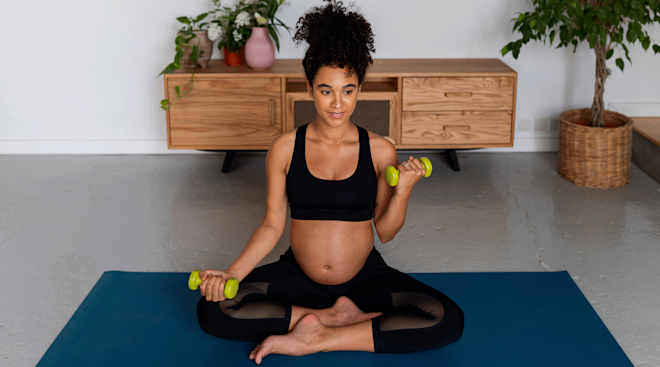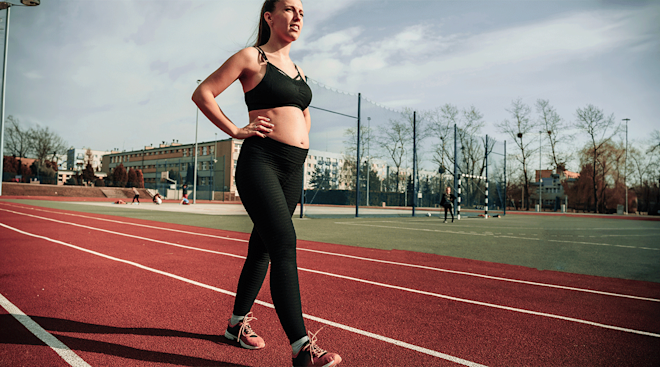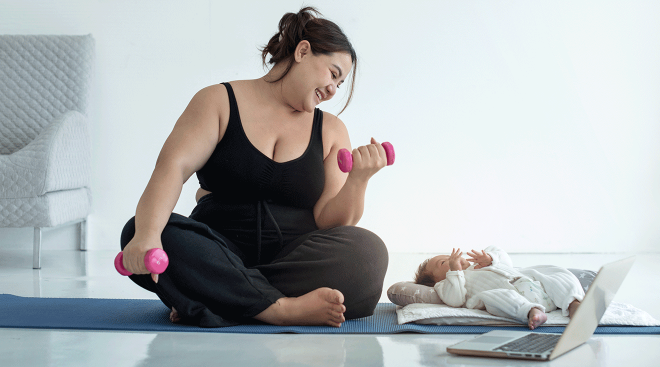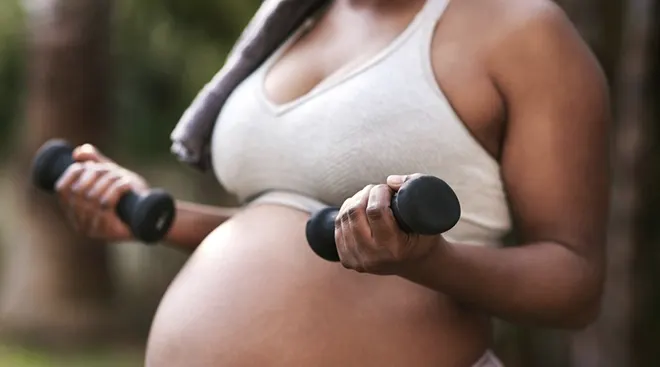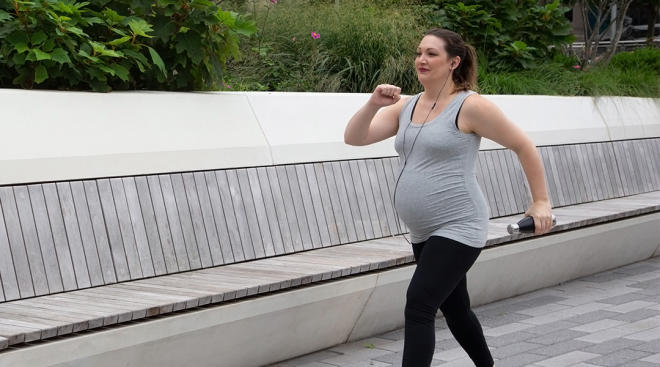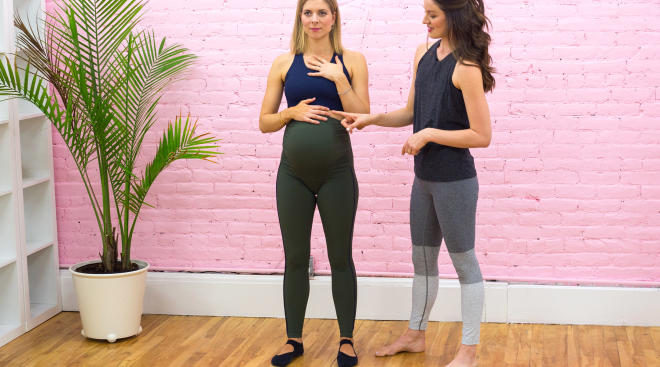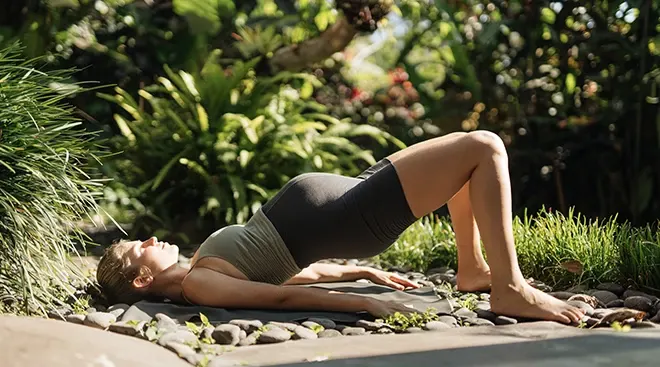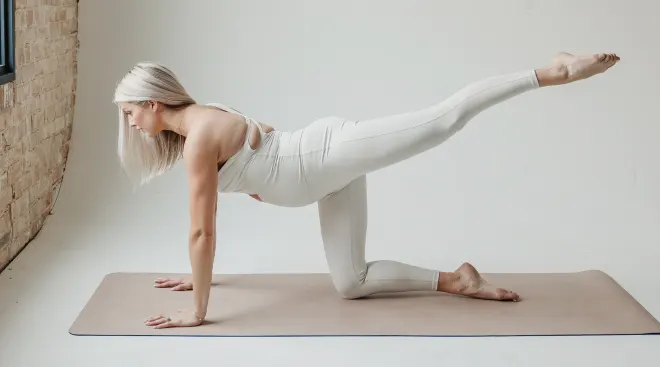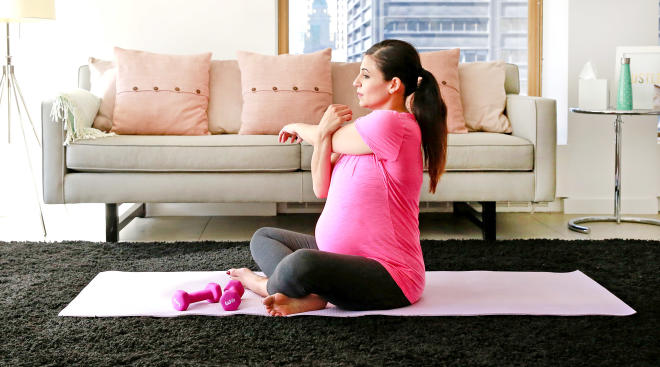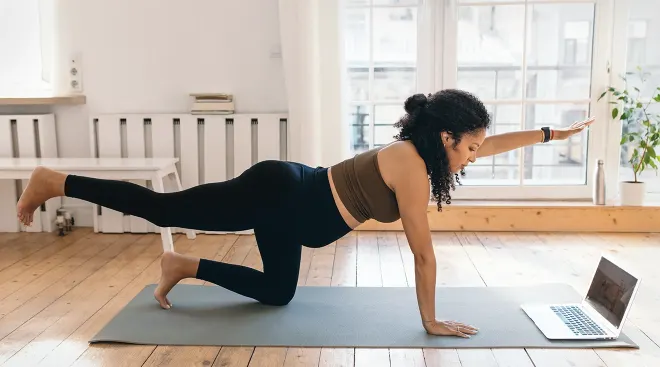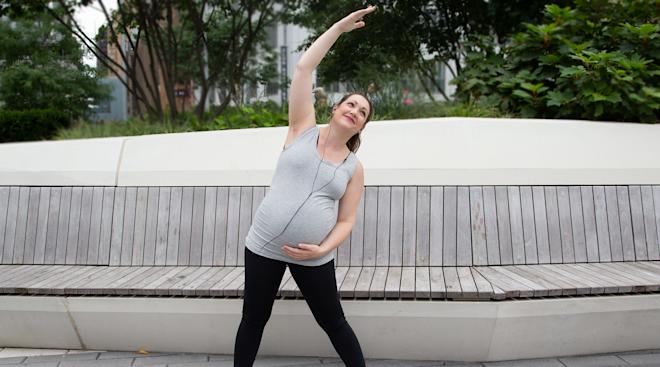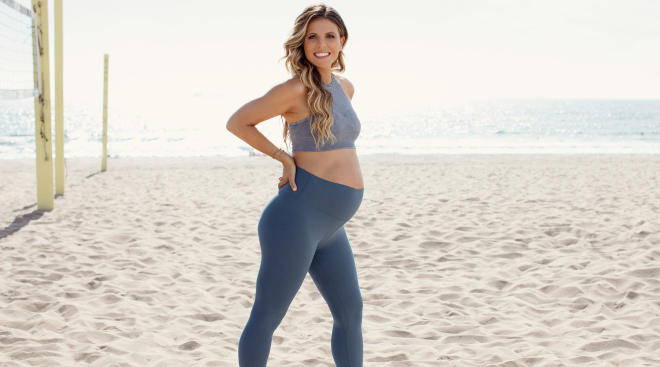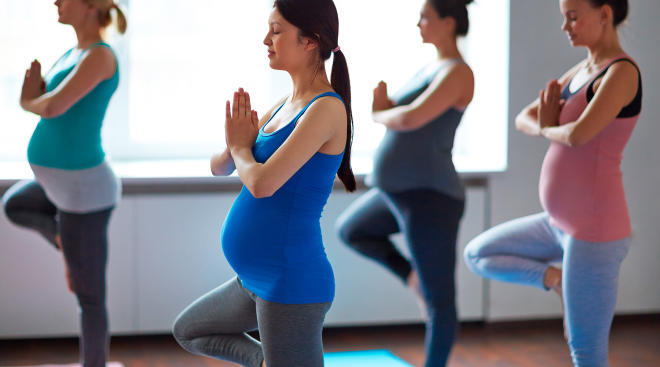Everything You Want to Know About Prenatal Yoga
When it comes to exercise during pregnancy, prenatal yoga is often touted as one of the best options for expecting parents. It boasts numerous benefits during what can be considered a physically and emotionally taxing stage of life, while also offering ample modifications to keep your growing body safe and comfortable. Here, experts share what to know about yoga during pregnancy before you start your own routine. Read on to learn how to practice poses, plus get tips to keep you feeling good in the coming weeks and months.
Prenatal yoga is yoga formatted specifically for pregnancy. “It usually involves modified yoga poses and breathing techniques that are safe and beneficial for [a pregnant person] and their growing baby,” says Ruth Mielke, a certified nurse midwife based in Tucson, Arizona. “The positions accommodate a growing belly and avoid [poses] that put too much pressure on the abdomen, or when the person is flat on their back.” (As pregnancy progresses, certain positions can be highly uncomfortable and present a dangerous situation for baby if they compress the vena cava, a major vein that supplies blood to the placenta.)
There are several benefits of prenatal yoga for pregnant people, including pain relief, better sleep and bonding with baby.
-
Pain relief: It’s no secret that pregnancy comes with its fair share of aches and pains. You’re physically transforming to accommodate baby, and this, of course, can be uncomfortable. The beauty of prenatal yoga is that it’s designed to work with your changing body throughout the various stages of pregnancy, explains Kate Lombardo, a mom and yoga director with YogaRenew. What’s more, prenatal yoga focuses on stretching and alignment, both of which can improve posture and flexibility, as well as offer some pain relief.
-
It prepares your body for childbirth: Labor and delivery require a ton of stamina, core strength and breath work—all of which are improved by yoga in pregnancy, says Lombardo. It also can help open the pelvis and the hips, as well as strengthen the pelvic floor.
-
It improves mental and emotional health: Pregnancy isn’t just physically taxing, it can also take a big toll on your mental and emotional health. Many prenatal yoga classes include meditation and relaxation techniques, which can alleviate stress and help you cope with the emotional changes of pregnancy, Mielke says. In fact, studies have found pregnancy yoga can help with both prenatal and postpartum depression. “I think what yoga in general does is help us to learn how to focus on the present moment and the task at hand and accept things for what they are,” Lombardo says.
-
It helps you build a supportive community: If you’re taking in-person prenatal yoga classes, another benefit is finding a community of people going through similar experiences. With all the unknowns and changes that pregnancy brings, it’s important to find people who can relate to and validate your experience. “If you don’t have people in your life that are in that same exact season of life, prenatal yoga can really offer a community [and a chance to] connect with people,” Lombardo says. “It just feels so much more supportive.”
-
It can help reduce blood pressure: Research has noted a correlation between prenatal yoga and reduced pregnancy complications due to high blood pressure. Furthermore, the American Pregnancy Association notes this may improve fetal outcomes, such as decreased risk for preterm labor and intrauterine growth restriction (IUGR).
-
It promotes healthy weight management: Weight gain is a crucial and healthy part of pregnancy, but it’s important to put on weight in a steady and healthy way to help avoid adverse outcomes like gestational diabetes and preeclampsia, the American Pregnancy Association says. Pregnancy yoga can encourage healthy weight gain, as it improves metabolism and can bring increased awareness to dietary and health habits, Mielke explains.
Wondering when you should start prenatal yoga? It’s safe to practice at any point in pregnancy, as long as your medical provider has given you the green light. (Some women at risk for preterm labor may not be advised to do prenatal yoga, notes the American Pregnancy Association.)
“The great thing about prenatal yoga is that it can be practiced throughout each trimester as long as modifications are made to help accommodate the body as it grows,” Lombardo says. And as long as you receive the all clear from your doctor, you don’t need prior yoga experience. That said, you should chat with your ob-gyn or a class instructor about modifications needed for each trimester. “Some classes are even designed to address the different needs of each trimester,” Mielke adds. Below, some things to expect for prenatal yoga by trimester:
Prenatal yoga in the first trimester
The first trimester is infamous for bringing on nausea, morning sickness and utter exhaustion. Because these symptoms are due to hormonal fluctuations, it’s unlikely you’ll be able to fully alleviate symptoms with yoga, Lombardo says. That said, prenatal yoga in the first trimester can help to “open the diaphragm,” which may reduce effects; it can also teach you breathing techniques to help you cope.
Prenatal yoga in the second trimester
Once the morning sickness subsides after the first trimester, many people report increased energy levels. Lombardo describes prenatal yoga in the second trimester as the sweet spot: “Most people are able to feel strong and comfortable while moving through the poses of a prenatal class.” It’s also a great time to work on improving your strength and flexibility to prepare for labor.
Prenatal yoga in the third trimester
As the body prepares for childbirth and your bump grows big, your center of gravity will change, and it can be harder to physically find balance. For prenatal yoga in the third trimester, Lombardo recommends using props, as well as widening the feet during any standing poses to create a more stable base.
Wondering where to find prenatal yoga classes? Like so many other fitness options these days, you can either take prenatal yoga classes in person at a yoga studio near you or online. “Some community centers offer prenatal classes, [and you can also] check with local hospitals and birth centers,” advises Mielke. Lombardo recommends finding an in-person prenatal yoga center, if possible, and taking a couple of classes to get the guidance of a certified prenatal yoga instructor. They can watch you practice and offer modifications.
Once you have the basics covered, online classes can be great. “Sometimes, you’re just so exhausted—getting out and finding a studio or class can be really hard,” Lombardo says. “[Online classes] can be a really good option to do at home as a form of self-care throughout pregnancy.” If you decide to do online prenatal yoga—whether through a digital class subscription or via free prenatal yoga videos online—Lombardo strongly suggests getting the props used in a standard prenatal yoga setup: a bolster, two blankets and two blocks. “It’s important because you need those props in order to be supported,” she says. They also help you modify yoga poses.
It’s important to know that each instructor will have their own style of teaching, so classes may vary, Lombardo says. However, one example of a prenatal yoga class structure is as follows:
- An introduction that allows students to share more about where they are in their pregnancy journey. “This helps to create a sense of safety and community, and is an opportunity for the teacher to get to know what’s happening with each student,” Lombardo says.
- A warm up that includes modified sun salutations to help students connect their movement to their breath
- Standing postures that work on strength and flexibility and lead up to a “peak pose,” which serves as the central physical goal
- Breathing exercises that help students connect to their pelvic floor and transversus abdominal muscles
- Cool down stretches, including savasana, and more guided breathing exercises to help students relax and connect to baby
Whether you’re considering taking an in-person class or joining one online, there are a few basic and common prenatal yoga poses to know. Lombardo breaks four of them down here:
Cat and cow
Not only does this prenatal yoga pose help you connect movement to breath, it also gently moves and stretches the spine, which can help relieve any aches and discomfort.
How to do it: Come onto all fours with your hands stacked under your shoulders and your knees under your hips. Breathe in and gently arch your back so your belly drops toward the floor and your chest rises towards the ceiling. This is cow pose. Then, breathe out and round your spine towards the ceiling, spreading your shoulder blades, and drop your neck towards the floor. This is cat pose.
Goddess pose
“This pose puts both of the legs in external rotation which helps to open the pelvis and make room for baby to move downwards into the right position for birth,” Lombardo says. It also allows for intuitive swaying, which can help relieve any discomfort in the torso and lower body.
How to do it: Stand with your legs wider than hip distance, with your heels facing in and toes facing out. Come into a high squat by bending your knees (make sure the feet are wide enough that they don’t go past your ankles) and lowering your hips.
Anjaneyasana with a side lean
Also known as a “low lunge,” this pregnancy yoga pose helps to open up the psoas muscle in your pelvis. “This is another important area to release because it cradles the uterus and can have an effect on baby’s position,” Lombardo says. “The side lean helps to create space around the ribs and whole abdomen as well.”
How to do it: Come down onto all fours with your hands on blocks. (The blocks should be on the floor at their highest setting.) Next, step your right foot forward between the blocks and shift the hips forward. You should feel a stretch in the hip flexors of the back leg and in the crease of the front hip. Raise your left arm overhead and bring the right forearm to the top of the right thigh. Gently lean toward the right to feel a stretch on the left side body. Repeat the stretch on the other side.
Wide-legged squat
This pregnancy yoga pose helps open the pelvic inlet, which allows baby to “move down towards the cervix,” Lombardo says. It also helps to relax the pelvic floor, which is important practice for labor.
How to do it: Stand with your feet a bit wider than hips-width distance and slightly turn your heels in and toes out. Squat down, making sure your knees don’t go past the ankles. To support yourself, place a block under your seat.
Always do your research before taking a prenatal class to ensure the instructor has the right training and certifications. This is usually more of an issue online, as it can be harder to vet people on the screen than in a certified studio. “If you just go on YouTube and find someone random, you don’t know exactly what their background is,” warns Lombardo.
Pregnancy yoga typically doesn’t have too many risks. It’s important to evaluate how you feel and make modifications, as needed. That said, some prenatal yoga poses may prove uncomfortable or be completely off limits during pregnancy. Here are some safety tips to keep top of mind:
-
Avoid laying on your back: Any poses that require you to lay on your back, like savasana and reclined goddess pose, should be modified using a bolster that can prop you up to a 45-degree incline, especially after 20 or so weeks, advises Lombardo.
-
Don’t do deep twisting: This may naturally not feel as good as your bump gets bigger, so it’s best to avoid it, Lombardo says. “It’s pretty obvious when [deep twisting] becomes not really possible to do.”
-
Be careful with deep back-bending: While each person’s comfort with back-bending postures will vary, Lombardo says to be mindful of prenatal yoga poses that require extreme back-bends, like full wheel pose and upward facing dog pose. “You’re already becoming so extended and open throughout the abdomen that, if you continue to do these big back bends where you’re opening further—it’s not necessarily unsafe—but it doesn’t feel so good,” she explains. Of course, others may be able to [do] extreme back-bends throughout pregnancy, she says. “If it feels okay, that’s great. There are exceptions to every rule.”
-
Avoid heated yoga: Hot yoga, also known as Bikram yoga, isn’t safe for pregnant women, notes the American Pregnancy Association. Anything that increases body temperature during pregnancy (such as heated yoga, hot tubs and fevers) can potentially cause neural tube defects and other adverse outcomes.
-
Stay hydrated: Pregnant women should drink anywhere from 8 to 12 glasses of water daily, advises the American Pregnancy Association. This helps maintain the health of the amniotic fluid, amniotic sac and placenta, all of which protect and nourish baby in-utero. Whether you’re practicing prenatal yoga or another form of exercise, drink plenty of water to avoid dehydration.
Ultimately, one of the most important aspects of prenatal yoga safety is listening to your body. Do what feels right for you, and know that may change from class to class. “It’s completely fine to back out of a pose,” Lombardo says. “Make the choices that are going to help you feel empowered through movement, versus feeling hindered by something. You really want it to work with your body as it changes, as opposed to against it.”
Please note: The Bump and the materials and information it contains are not intended to, and do not constitute, medical or other health advice or diagnosis and should not be used as such. You should always consult with a qualified physician or health professional about your specific circumstances.
Plus, more from The Bump:
Kate Lombardo is yoga teacher with 200 hours of training and over a decade of experience. Lombardo currently serves as the yoga director for YogaRenew, a digital platform that offers online yoga teacher training and classes. She also teaches at an in-person studio in Hoboken, New Jersey, where she lives with her husband and two children.
Ruth Mielke, RN, CNM, is a registered nurse and certified nurse midwife who gained her certification through the American Midwifery Certification Board. She received her master’s degree in nursing from Case Western Reserve University and her doctorate in nursing practice from Frontier Nursing University. Mielke currently serves as a nurse health writer with the Nursing Pen, based in Tucson, Arizona.
BMC Pregnancy and Childbirth, Prenatal yoga for young women: A mixed methods study of acceptability and benefits, November 2019
Complementary Therapies in Clinical Practice, A randomized control trial to study the effect of integrated yoga on pregnancy outcome in hypertensive disorder of pregnancy, May 2021
American Pregnancy Association, Prenatal Yoga, 2023
American Pregnancy Association, Pregnancy Weight Gain, 2023
Learn how we ensure the accuracy of our content through our editorial and medical review process.
Navigate forward to interact with the calendar and select a date. Press the question mark key to get the keyboard shortcuts for changing dates.

































